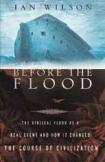Inundation or Interpretation?
Chapters 6 through 8 of the Book of Genesis tell how God, in response to human wickedness, sent a flood to wipe out the human race, sparing only the righteous Noah and his family and the animals they gathered into their ark. The biblical account interweaves two versions, an older one (conventionally called the Yahwist account) and a later one (conventionally, the Priestly version) that adapted the story in the sixth-century B.C.E. for a new audience of exiles. There are differences: the Priestly source has two pairs of every animal, whereas the Yahwist source has seven pairs of clean animals and two pairs of unclean; the flood in the Priestly source is the bursting forth of the waters above and below the earth, whereas in the Yahwist it is a 40-day rain. The biblical account is traceable to an ancient Mesopotamian story of a great flood, which is mentioned in the Sumerian King List, the Sumerian Flood Story, the 11th tablet of the Gilgamesh Epic and the Atrahasis Epic. The latter work is the likely source of Genesis 2 to 11, for in both stories the flood figures in a plot that includes the creation of the human race, a fault, the flood as punishment and a post-flood revision of creation. None of the extant works mentioning the flood are earlier than the late third millennium B.C.E., but it is commonly assumed the tradition is earlier.
The biblical flood has fascinated people through the ages. One famous “discovery” of evidence of the flood was the massive mud layer excavated at Tell el-Mukayyar in 1929 by Sir Leonard Woolley and widely publicized by him. As no other Mesopotamian city yielded anything similar, it is now thought that Woolley found the remnants of a local flood. Aware of such false starts, Ian Wilson, the author of the best-selling The Shroud of Turin and The Blood and the Shroud, is nonetheless convinced the ancient literary accounts refer to an actual flood. He can date it precisely, 5600 B.C.E., when a swollen Mediterranean Sea broke through the narrow land mass separating it from the land-locked Black Sea, at that time a relatively small fresh-water lake surrounded by human settlements of advanced culture. The date is established through radiocarbon dating artifacts from the shores of the original lake, which have been recovered by underwater archaeology.
By Wilson’s reckoning, 10 cubic miles of water daily roared through the Bosporus (200 times the flow over Niagara Falls) at 50 miles an hour. The Black Sea rose six inches a day and eventually inundated approximately 60,000 miles of lakeside dunes and grassland. Wilson’s only doubts are about what happened to the people after the inundation. A benchmark in his quest is the sixth-millennium city of çatal Hüyük (in present-day Turkey), for aspects of its culture (including the bull cult and the prevalence of the Great Mother Goddess’s matrilineal order) survived in Crete, Saharan Africa and Egypt. These survivals suggest to Wilson that the refugees from the flood sailed to these places in oceangoing vessels.
Wilson is an amateur in the best sense of the word, enthusiastic, capable of writing a fascinating account and, for the most part, drawing on respectable authorities. He is a literary detective, however, rather than a historian. In the featureless swamp of early Mediterranean history, Wilson leaps fearlessly from tussock to quaking tussock, at each leap brandishing yet another piece of evidence. Even Plato’s Atlantis myth is made to yield data. He has not, however, even come close to demonstrating his thesis. At best he provides substantial evidence for a flood-like event when the Mediterranean burst upon the Black Sea. But he has not proved this event was the source of the Mesopotamian and biblical accounts of the flood.
Was there an ancient flood, and does Genesis record it? A surprising number of ancient traditions record a great flood, particularly in the Semitic and Greek world. It is certainly possible that a historical flood was the basis of these literary accounts. Literature transforms historical events, however, and invests them with cosmic symbolism, so that a narrative need not resemble the event upon which it is based. In the case of the flood in ancient Near Eastern literature, there need not have been a real event, for primordial and uncontrolled waters symbolized chaos, as in the Mesopotamian poems “Ninurta” and “Enuma elish” and in Gn 1:1-3; Ps 89:5-12; and Is 51:9-11, to give but three biblical examples. It would be natural for poets to imagine divine punishment as a return to the chaotic past. The Priestly version of the flood does exactly that, making the flood an upswelling of the previously tamed cosmic waters of Genesis 1. Moreover, Genesis 2-11 differs from the rest of the Bible by its genre, a creation-flood story like the Atrahasis story mentioned above. In the genre, the flood functions as the punishment inflicted by God upon a corrupt human race. The storyteller is not writing history in a modern sense.
Before the Flood has its charms, but it does not illuminate the Bible.
This article also appeared in print, under the headline “Inundation or Interpretation?,” in the March 17, 2003, issue.








